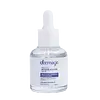What's inside
What's inside
 Key Ingredients
Key Ingredients

 Benefits
Benefits

 Concerns
Concerns

 Ingredients Side-by-side
Ingredients Side-by-side

Water
Skin ConditioningNiacinamide
SmoothingHydroxyethyl Urea
HumectantGlycerin
HumectantPolysorbate 60
EmulsifyingPhenoxyethanol
PreservativeCaprylyl Glycol
EmollientPanthenol
Skin ConditioningParfum
MaskingBenzyl Salicylate
PerfumingCitronellol
PerfumingHydroxycitronellal
PerfumingLimonene
PerfumingAminomethyl Propanol
BufferingCarbomer
Emulsion StabilisingAmmonium Acryloyldimethyltaurate/Vp Copolymer
Dipropylene Glycol
HumectantSodium Hyaluronate
HumectantYeast Extract
Skin ConditioningCalcium Pantothenate
Acacia Senegal Gum Extract
Poloxamer 407
EmulsifyingPolyvinyl Alcohol
Ethylhexylglycerin
Skin ConditioningGlyceryl Caprylate
EmollientGlyceryl Undecylenate
EmollientHyaluronic Acid
HumectantWater, Niacinamide, Hydroxyethyl Urea, Glycerin, Polysorbate 60, Phenoxyethanol, Caprylyl Glycol, Panthenol, Parfum, Benzyl Salicylate, Citronellol, Hydroxycitronellal, Limonene, Aminomethyl Propanol, Carbomer, Ammonium Acryloyldimethyltaurate/Vp Copolymer, Dipropylene Glycol, Sodium Hyaluronate, Yeast Extract, Calcium Pantothenate, Acacia Senegal Gum Extract, Poloxamer 407, Polyvinyl Alcohol, Ethylhexylglycerin, Glyceryl Caprylate, Glyceryl Undecylenate, Hyaluronic Acid
Water
Skin ConditioningPropanediol
SolventGlycereth-7 Triacetate
EmollientPhenoxyethanol
PreservativePEG-40 Hydrogenated Castor Oil
EmulsifyingPPG-1-PEG-9 Lauryl Glycol Ether
EmulsifyingSodium Hyaluronate
HumectantAminomethyl Propanol
BufferingBetaine
HumectantCarbomer
Emulsion StabilisingEthylhexylglycerin
Skin ConditioningParfum
MaskingDisodium EDTA
Sodium PCA
HumectantHyaluronic Acid
HumectantSodium Lactate
BufferingLactobacillus Ferment Lysate
Skin ConditioningPCA
HumectantSerine
MaskingAlanine
MaskingGlycine
BufferingBiosaccharide Gum-4
Skin ConditioningGlutamic Acid
HumectantLysine Hcl
Skin ConditioningThreonine
Arginine
MaskingPotassium Sorbate
PreservativeSodium Benzoate
MaskingProline
Skin ConditioningWater, Propanediol, Glycereth-7 Triacetate, Phenoxyethanol, PEG-40 Hydrogenated Castor Oil, PPG-1-PEG-9 Lauryl Glycol Ether, Sodium Hyaluronate, Aminomethyl Propanol, Betaine, Carbomer, Ethylhexylglycerin, Parfum, Disodium EDTA, Sodium PCA, Hyaluronic Acid, Sodium Lactate, Lactobacillus Ferment Lysate, PCA, Serine, Alanine, Glycine, Biosaccharide Gum-4, Glutamic Acid, Lysine Hcl, Threonine, Arginine, Potassium Sorbate, Sodium Benzoate, Proline
Ingredients Explained
These ingredients are found in both products.
Ingredients higher up in an ingredient list are typically present in a larger amount.
Aminomethyl Propanol is used to adjust the pH of products. It is also used as a base to create other organic compounds. Having a balanced pH is important for protecting your skin.
Aminomethyl propanol is safe to use in cosmetics up to 1%. It is soluble in water.
Carbomer is a polymer of acrylic acid. Its main role is to create a gel consistency.
A high amount of carbomer can cause pilling or balling up of products. Don't worry, most products contain 1% or less of carbomer.
Ethylhexylglycerin (we can't pronounce this either) is commonly used as a preservative and skin softener. It is derived from glyceryl.
You might see Ethylhexylglycerin often paired with other preservatives such as phenoxyethanol. Ethylhexylglycerin has been found to increase the effectiveness of these other preservatives.
Hyaluronic acid is naturally found in healthy skin. It is a humectant, meaning it draws moisture to your skin.
This ingredient helps hydrate, soothe, and protect the skin.
What makes hyaluronic acid so hydrating? It has the capacity to bind or hold large amounts of water.
Fun fact: It is already naturally found in our bodies, such as the fluids of our eyes and our joints.
Studies find this ingredient to have anti-inflammatory and anti-microbial properties. This can help speed up wound-healing.
Hyaluronic acid can be irritating if the molecule has a low-molecular weight, or if the molecules are small.
One study found low-molecular weight hyaluronic acid to be pro-inflammatory, meaning some people may experience irritation. This is because our bodies use hyaluronic acid in the wound-healing process to signal to our bodies, via irritation, that something needs healing.
The same study found high-molecular weight hyaluronic acid to be anti-inflammatory.
These are some other common types of Hyaluronic Acid:
Learn more about Hyaluronic AcidParfum is a catch-all term for an ingredient or more that is used to give a scent to products.
Also called "fragrance", this ingredient can be a blend of hundreds of chemicals or plant oils. This means every product with "fragrance" or "parfum" in the ingredients list is a different mixture.
For instance, Habanolide is a proprietary trade name for a specific aroma chemical. When used as a fragrance ingredient in cosmetics, most aroma chemicals fall under the broad labeling category of “FRAGRANCE” or “PARFUM” according to EU and US regulations.
The term 'parfum' or 'fragrance' is not regulated in many countries. In many cases, it is up to the brand to define this term.
For instance, many brands choose to label themselves as "fragrance-free" because they are not using synthetic fragrances. However, their products may still contain ingredients such as essential oils that are considered a fragrance by INCI standards.
One example is Calendula flower extract. Calendula is an essential oil that still imparts a scent or 'fragrance'.
Depending on the blend, the ingredients in the mixture can cause allergies and sensitivities on the skin. Some ingredients that are known EU allergens include linalool and citronellol.
Parfum can also be used to mask or cover an unpleasant scent.
The bottom line is: not all fragrances/parfum/ingredients are created equally. If you are worried about fragrances, we recommend taking a closer look at an ingredient. And of course, we always recommend speaking with a professional.
Learn more about ParfumPhenoxyethanol is a preservative that has germicide, antimicrobial, and aromatic properties. Studies show that phenoxyethanol can prevent microbial growth. By itself, it has a scent that is similar to that of a rose.
It's often used in formulations along with Caprylyl Glycol to preserve the shelf life of products.
Sodium Hyaluronate is hyaluronic acid's salt form. It is commonly derived from the sodium salt of hyaluronic acid.
Like hyaluronic acid, it is great at holding water and acts as a humectant. This makes it a great skin hydrating ingredient.
Sodium Hyaluronate is naturally occurring in our bodies and is mostly found in eye fluid and joints.
These are some other common types of Hyaluronic Acid:
Learn more about Sodium HyaluronateWater. It's the most common cosmetic ingredient of all. You'll usually see it at the top of ingredient lists, meaning that it makes up the largest part of the product.
So why is it so popular? Water most often acts as a solvent - this means that it helps dissolve other ingredients into the formulation.
You'll also recognize water as that liquid we all need to stay alive. If you see this, drink a glass of water. Stay hydrated!
Learn more about Water